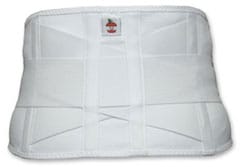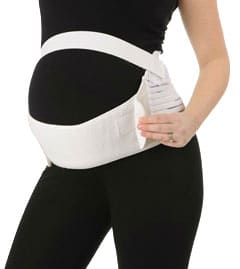If you’re dealing with any type of back pain, the temptation to try just about anything short of surgery is definitely there. From topical ointments to exercises to pain medication, you’re willing to try just about anything. One of the things you’ve likely heard of is wearing some sort of belt for back pain.
A properly designed back pain or decompression belt will help some people with lower back pain. It’s not a cure, but the right product can work in conjunction with other methods to provide some relief. For some specific pain in the lower back and pelvis, your doctor may recommend either a sacroiliac or lumbosacral belt. These are two of the most common spinal braces.
 Sacroiliac Belts
Sacroiliac Belts
These specialized belts are for people who have issues with their sacroiliac joints (more commonly known as SI joints in their spine). These joints are found at the base of your spine where the sacrum connects to the pelvis. These joints can often get damaged due to injury, osteoarthritis, or simply age which allows them to move more than they are supposed to.
Sacroiliac joint dysfunction is another cause of lower back pain. The sacroiliac belt’s job is to compress the area around the hip to not allow the SI joints the excessive movement they would have otherwise, which causes pain.
 Lumbosacral Belts
Lumbosacral Belts
This type of belt’s main job is to provide pressure on your stomach and abdominal muscles to take some of the pressure and stress off your lower back. The lumbosacral belt or brace stabilizes the lower spine and allows the best healing environment for various lower back issues including muscle pulls and strains.
Stabilizing the Back
If the underlying cause for your back pain is a pulled muscle, your doctor has likely told you to keep still as much as possible. It’s only when you try to follow that advice that it becomes apparent how hard it is to follow. Because back muscles take a longer than average time to heal, simply resting is most often not enough and investing in a decent back support belt will speed the healing along in many cases.
The right type of belt will ease some of the stress on those pulled muscles. By allowing you to walk or sit without placing more strain on the muscles, the inflammation will subside faster. Don’t expect to be up and doing the tango once the belt is in place. You’ll still have some pain, but stabilizing the lower back helps you avoid turning in one direction and experiencing shooting pains that run across your back and down the legs.
Supporting Weight
A properly designed belt for lower back pain will also take the pressure off your back if you are currently carrying some extra weight. Extra weight does not mean that you have a spare tire around your middle.
Women who are opulently endowed sometimes find that these belts ease lower back pain while they ponder the ideas of breast reduction surgery. If this is the reason why you’re considering purchasing a support belt, talk with your doctor first. That will make it easier to find out what qualities the best must have in order to do any good.
Easing Tension in the Lower Back
There are times when the lower back pain is the result of stress or tension. Your job may be demanding and you tend to tense your muscles. That can be a bad thing, especially if you spend a lot of time on your feet (without a good pair of work shoes for back pain) or lift heavier objects as part of your work responsibilities.
You may find that a back belt helps to decompress your lower back and allows you to get through the day with a minimum of pain. This is especially true for those with physically demanding jobs or those that are on their feet for hours at a time such as nursing.
Keep in mind that belt is not going to make stress go away. You’ll need to talk with a doctor and see what can be done to deal with the stress at work. What it will do is help you get by until a more permanent solution is identified.
 Back Belts and Pregnancy
Back Belts and Pregnancy
You’ve probably seen ads or talked with someone who recommended a decompression belt to provide lower back support during a pregnancy. Tread lightly if this is what you have in mind. The last thing you want to do is buy a belt and start wearing it without talking with your physician.
Some women do obtain a measure or relief by wearing this type of belt during certain trimesters. If your doctor thinks it might help, make sure whatever belt you choose meets the guidelines that the medical professional provides. What you want is support without any type of constraints that could harm the baby. This type of back belt while on your feet and a good pregnancy pillow while laying down is a great combo.
Sorting the Wheat from the Chaff
If your doctor believes some type of back pain belt will help your situation, there is the need to find the best possible product. As you will find out quickly, some highly touted products don’t deliver the goods. The Dr. Ho 2-In-1 Back Relief Belt is a good example.
Some people find that the belt does absolutely nothing for them. They can wear the belt all day and the only thing it accomplishes is to make the middle look larger. It can also be uncomfortable in terms of retaining heat around the middle.
Others do note a slight difference, as long as they wear the belt. The moment that it comes off, whatever bit of relief they experienced disappears. Some customers note the belt begins to break down after a couple of months.
There’s also the cost of the product. You’ll find other belts that provide at least some benefits and happen to cost much less. While it may not help everyone, I personally recommend the ComfyMed back brace for a good inexpensive, back pain decompression belt.
Remember that a back pain or a decompression belt is not always the best course of treatment. Never buy one without talking with your doctor first. You may find that in your case, a combination of physical therapy and medication for the pain will be your best bet.
Adam
Latest posts by Adam (see all)
- Running and Lower Back Pain (Before, During, and After Running) - July 1, 2019
- Benefits of Swimming Pool Exercises for Back Pain - March 20, 2019
- Care Options for Seniors With Back Pain - September 4, 2018


 Sacroiliac Belts
Sacroiliac Belts Lumbosacral Belts
Lumbosacral Belts Back Belts and Pregnancy
Back Belts and Pregnancy